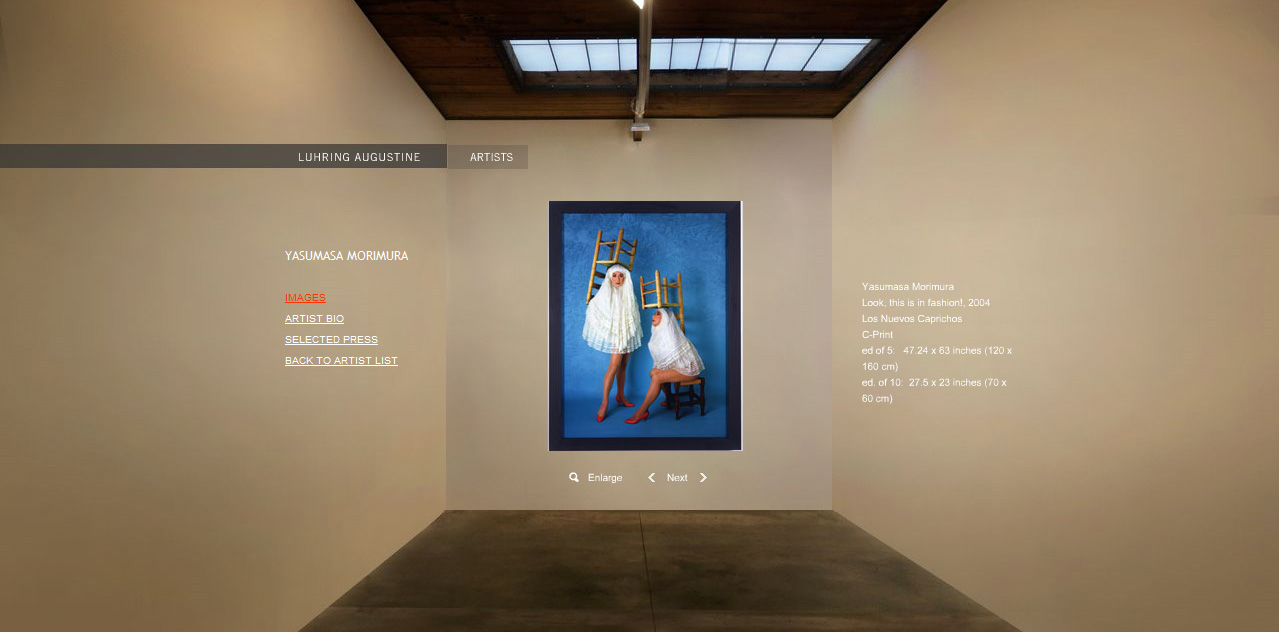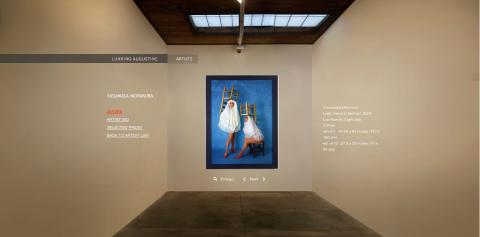ελληνικά

CLICK ON IMAGE to view Yasumasa Morimura in Luhring Augustine Gallery
Yasumasa Morimura is a special case in the artistic scene of the last twenty years for various reasons. His artworks constitute photographic works as well as performances, the roles he performs become challenges for the artistic representation of the human body and he uses media of many different types.
From the beginning of his career, he turned to the appropriation of western iconography and not to the "original" artistic creation. To him the art of the past is a source of inspiration, which could possibly become a testimony of contemporary era and a pre-icon of future. Morimura's art deconstructs established images of art history and poses questions concerning the status of western masterpieces then and nowadays, the imposition of western iconography and its reception by non european cultures.
Daughter of Art History is a series Morimura dedicated to paintings of the past. It begun in 1985 with the artwork Portrait (Van Gogh), a reference to the Self-portrait with bandaged ear (1889) by Van Gogh and to the notion of the suffering body of the artist, and it continues until today. It is a series of photographic portraits where he identifies himself with famous models of paintings from the era of high renaissance to the 20th century. The final photographic result is an alternative version of famous museum pieces, which introduces a dialogue between past and present, painting and photography, high art and parody.
In his photographs he impersonates various roles identifying at the same time with women as well as with men. His technique recalls the japanese theater Kabuki and No, where only men performed all the parts. Morimura says that he chooses specific artworks because of the ambiguity he sees in them. His photographs manage to puzzle contemporary viewers as they can not clearly understand the identity of the person represented.
The final result provokes multiple questions. What does Yasumasa Morimura aim to do when he impersonates various models of western masterpieces, mainly women? Which is his intention when, through his hybrid figures, equates his asian-"exotic" identity, according to western stereotypes, with the female gender?
Morimura comments mainly on the reception of european art in his country and on the result of this procedure, as it is reflected in hybrid icons of contemporary life in Japan. According to Morimura, he grew up in a country where the most important artists came from the West, while the japanese artistic tradition and heritage came in second place. The acceptance of the western superiority from the part of japanese people resulted in a mixed way of leaving and in artistic expressions balancing between modern and kitsch aesthetics.
The commercial aspect of art and the dimension of this phenomenon in Japan is another important point of view so as to understand his work. The artworks Morimura chooses as the base of his photographic transformations exist through various and multiple media, such as book illustrations,carte-postals, posters, etc. In his turn, Morimura works via photographs of the artworks he refers to, adding through his own pictures another circle to the reproductive chain deriving from a masterpiece.
The already supposed contact of the spectators with the museum pieces becomes even more tensed as they face the transformation of an already famous, emotionally and ideologically charged work of art. The spectators are invited to think about the reason of their prior interest in the original artwork and the reason of feeling puzzled when dealing with a spectacle not easily identified and placed under aesthetic categories.
He confesses that he is interested in the procedure of looking and being looked at. The japanese photographer has developed a special interest in Rembrandt's self-portraits, which were painted from his youth to his death, where the artist is at the same time the subject-matter and the creator. Morimura, although he shares the same self-centered, narcissistic aspect with the famous painter, he differs in the fact that he distorts his image, leaving a constant question about his real identity.
The hybrid dimension of his work regards not only the final result, but also the media he employs, as his techniques vary and evolve gradually. In the beginning of his career he made the decor of his pictures in wax and captured the performance on film, without proceeding to any digital elaboration.
He used various techniques in order to elaborate his scenery according to the particularities of each artwork. He made a waxed three dimensional surface which represented the picture, leaving empty the space where the head of the model is supposed to be. The japanese artist put at this place his face and with the aid of make-up he impersonated the protagonist of the scene. Sometimes he impersonated in the same picture various roles.
These kind of photographs produce a peculiar visual result and have a satirical dimension. Furthermore, they evoke the photos taken at the amusement parks during the first decades of the 20th century, where the spectators posed through decors, which represented various human figures and situations. This surrealistric result attracted the artists of the Ecole de Paris, who found at the amusement parks another source of inspiration.
In addition, Morimura's artworks are an indirect allusion to the wax models, which constituted, before the arrival of photography, the most realistic representation of famous people and one of the most important exhibits at the anatomy museums.
In the course of time, the use of digital technology gave him the opportunity to proceed to changes which radically transform the subject matters he deals with. Nowadays, he profits the technique of montage and he addresses questions to spectators regarding the identity of the model he chooses to incarnate. Digital technology used by Morimura contributes to the surpassing of limits of the human body. His pictures refer to an alternative reality, beyond the norms of gender or race. By impersonating different models, he deletes the boundaries between male and female, european and japanese, original and copy. Thus, to Morimura, the use of digital technology acts as a lesson of contemporary anatomy, as nowadays via a computer the artist can impersonate different models, alternate their identity and break the boundaries regarding the representation of the human body.
...
Yasumasa Morimura, Daughter of Art History, Photographs by Yasumasa Morimura, Aperture, New York 2003, n.p.
Philipo Didosi, «Morimura à la Fondation Cartier de Jouy-en-josas », Connaissance des arts, no 493, Paris mars 1993, p.104.
Clément Cheroux, « Portraits en pied...de nez. L'introduction du modele récréatif dans la photographie foraine», Études photographiques, no 16,Paris mai 2005, p.89-107.
Another japansese photographer who is interested in capturing wax models and mainly those that represent models of artworks is Ηiroshi Sugimoto.
In 1835 the Museum of Μadame Tussald was founded in London and some years afterwards the Museum Grevin was founded in Paris.
Alain Corbin, Histoire du corps, v.2, De la Révolution à la Grande Guerre, Seuil, Paris 2005, p.207-89.
Yasumasa Morimura, Yasumasa Morimura:9 visages, Éditions de la Fondation Cartier pour l'art contemporain, Paris 1993, n.p.


